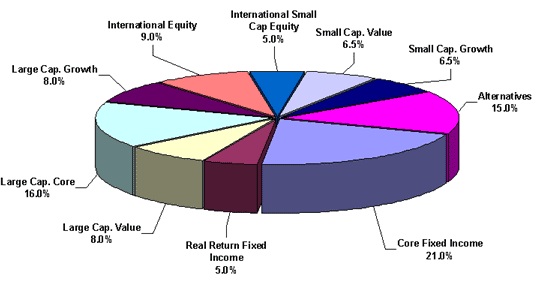Asset Allocation
Post on: 7 Апрель, 2015 No Comment

Which Stocks?
Lets say an investor has decided on a 60/40 stock-bond mix. Now that investor has another important issue to consider; that is, how to allocate that 60% of stock investments. This is where great opportunities can be found for improving the risk-return tradeoff. Investors who are willing to take on higher risk within the equity portion of their portfolio can tilt or overweight their equity allocation towards riskier asset classes with a history of above-average market returns.
According to research by Eugene Fama and Kenneth French, investors can increase their expected risk-adjusted return by holding a larger portion of small cap and value stocks. Over a lifetime, these stocks have higher average returns than large-cap stocks and growth stocks.
Research also shows that allocations to international small cap and value stocks diversify US portfolios better than international equities that are style and size neutral. These stocks are not highly correlated with the broad US equity market, and their higher expected returns and diversification benefits provide a good rational for including them in a portfolio.
Allocations to emerging market small cap and value stocks provide additional portfolio benefits via an even broader array of asset classes. With low variances and co-variances to the US market, the stock-bond ratio of a portfolio can be increased with the addition of these stocks without raising overall portfoliio volatility.
Real Estate Securities
Real estate securities add further diversification benefits to a portfolio because of their low covariance with other asset classes. Markets may experience varying levels of return correlation with real estate, but diversification with these securities can further reduce risk in a portfolio and result in higher expected long-term annualized returns.
The Limits of Diversification
Diversification is a powerful financial tool. By holding a collection of equity asset classes across global markets, investors can reduce or eliminate the impact of under-performance in a single market or region of the world. Diversification also increases the likelihood of capturing the premiums associated with different size and value risk factors. That said, diversification within equities cannot eliminate broad economic systematic risk. The only way to avoid systematic risk is to not be exposed to it, that is, to be out of the market.
Temper Portfolio Risk with Bonds
To temper the risk of equities investors are advised to add bonds (fixed income) to their portfolio. A bond is a debt security issued by a company, public authority, or government, and represents a promise to pay interest to the bondholder for a given period of time as well as to reimburse the original principal at maturity. Bonds are traditionally regarded as less risky than equities (stocks) since bondholders in most countries have a legal claim to an issuer’s assets. Bonds also have offered lower historical returns because the bond holder is not an equity owner and typically does not participate in company profits.
One purpose for holding bonds is to manage overall risk in a portfolio. Some long-term investors seek higher total expected returns by shifting risk to the equity side of their portfolio, while lowering risk with short-term bonds. These bonds have historically lower yields and are a good tool for tempering portfolio risk.
Bonds play an important role in helping to manage overall risk in a portfolio and generating reliable income. With this in mind some long-term investors may seek to earn higher total expected returns by shifting risk to the equity side of their portfolio. They use lower risk short-term bonds, which have historically offered lower yields, to temper portfolio risk.
The second purpose for holding bonds is to generate cash flow. Income-oriented investors, including retirees, pension plans, and endowments, may not be concerned about short-term price risk in their bond portfolio. Instead, their priority is to meet specific future obligations. They design their portfolios around bonds with longer maturities and/or lower credit ratings in hope of earning higher yields. Whether investing for total long-term return or for income, a bond portfolio should be diversified across issues and global markets.
Asset Allocation Process at Cardiff Park
The asset allocation advice we provide at Cardiff Park is based on a long-term buy and hold investment philosophy incorporating modern portfolio theory and principles of finance. The aim of a well-constructed asset allocation strategy is never just about making money. Its also about defining goals, managing risk, and developing a long-term plan that reflects each investors goals, timeline and financial situation.
At Cardiff Park each asset allocation plan begins with a comprehensive picture of a clients unique situation, risk tolerance, and risk capacity. This is the basis for determining the optimal allocation of equities, real estate, commodities, gold and fixed income.
Remember:
The initial decision about how much to allocate to stocks versus bonds is perhaps the most crucial decision affecting long-term term portfolio performance.
This decision can be made with lots of historical data and analysis. During the portfolio design process with Cardiff Park, well show you different stock-bond combinations that will help you visualize the risk-return tradeoff and range of potential outcomes over time.
Once the appropriate asset mix is determined, specific asset class choices can be considered. This is by no means a final decision. Over time, as investor risk preference or needs shifts, the asset allocation mix will be periodically revisited. Again, we will visually demonstrate how shifts in the portfolio mix may impact future wealth accumulation before decisions are made.














